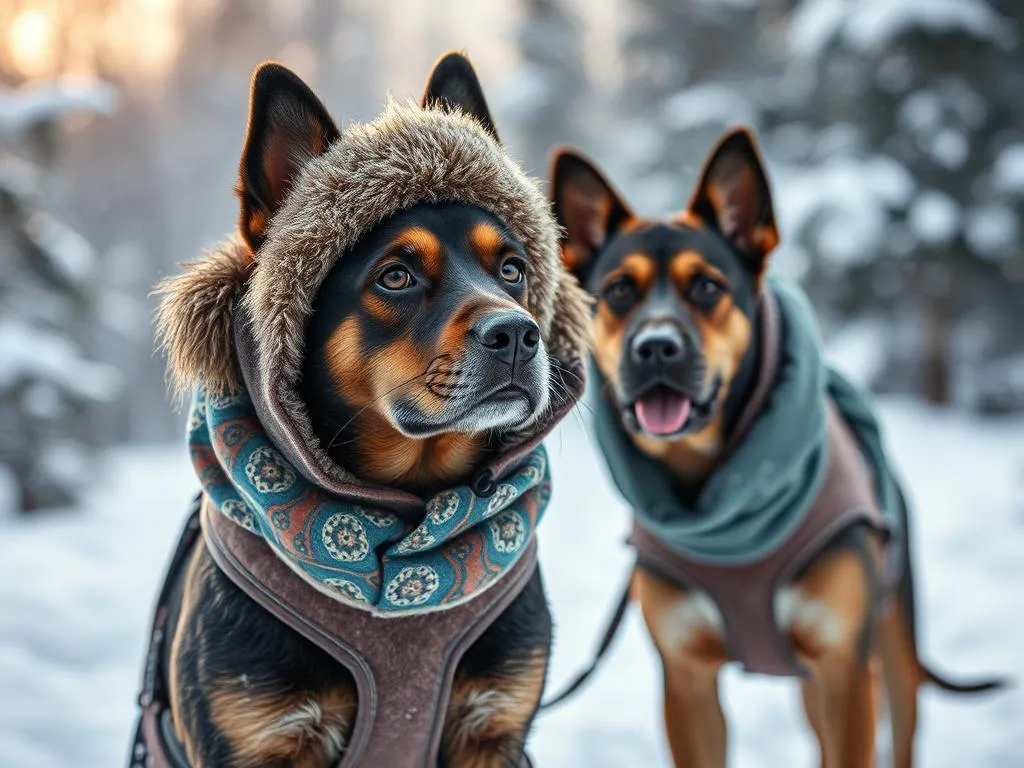
Introduction
As winter approaches, ensuring our furry friends are well-prepared for the cold is paramount. Just like humans, dogs can feel the chill, and essential winter gear for dogs is not just a luxury; it’s a necessity. Cold weather can affect a dog’s health and comfort, leading to discomfort or even serious health risks like frostbite or hypothermia. Understanding your dog’s winter needs and equipping them with the right gear can make all the difference in their winter experience.
In this article, we’ll explore the specific needs of dogs in winter, the essential winter gear for dogs, and practical tips for care and acclimation. From cozy coats to protective boots, we’ll cover everything you need to keep your canine companion safe and comfortable this winter.
Understanding Your Dog’s Winter Needs
Factors Influencing Winter Gear Requirements
When it comes to essential winter gear for dogs, several factors determine what your dog might need.
-
Size and Breed: Smaller breeds, those with short coats, or dogs that are not as physically active may need more protective gear than larger, more robust breeds like Huskies or Malamutes, which are naturally equipped to handle colder temperatures.
-
Age, Health, and Physical Condition: Puppies and senior dogs may require additional warmth due to their vulnerability. Dogs with health issues, such as arthritis, can also be more sensitive to cold and should be outfitted with appropriate gear.
-
Type of Winter Environment: Urban dogs might face different winter challenges than those in rural settings. Urban environments often have salt and chemicals, which can harm paws, while rural dogs might encounter deeper snow and colder temperatures.
Signs Your Dog May Be Cold
Knowing how to identify when your dog is feeling cold is crucial for their well-being. Look out for these behavioral and physical signs:
-
Behavioral Changes: If your dog starts shivering, whining, or seeks to burrow under blankets, they may be feeling the cold. Some dogs may even hesitate to go outside.
-
Physical Signs: Pay attention to how your dog holds their paws. If they frequently lift their paws off the ground or curl up tightly, they are likely uncomfortable.
-
Health Risks: Extreme cold poses serious risks, including frostbite and hypothermia. It’s essential to recognize these risks and act promptly if you suspect your dog is too cold.
Essential Winter Gear for Dogs
Winter Coats and Sweaters
One of the most critical components of essential winter gear for dogs is a good winter coat or sweater. Proper insulation and waterproof materials are crucial for keeping your dog warm and dry.
-
Types of Coats: You can choose from various options, including insulated jackets, fleece sweaters, and waterproof raincoats. Each type serves a unique purpose. For instance, an insulated jacket provides warmth, while a fleece sweater is ideal for layering.
-
Choosing the Right Fit: The right fit is essential for comfort and mobility. Measure your dog’s neck, chest, and length to find a coat that suits their size and breed. Look for adjustable straps to ensure a snug fit without restricting movement.
Dog Boots
Protecting your dog’s paws from the harsh winter elements is another vital aspect of essential winter gear for dogs. Dog boots can safeguard against snow, ice, and salt.
-
Purpose of Dog Boots: These boots not only keep paws warm but also protect against sharp ice and salt that can cause irritation or injury.
-
Features to Consider: Look for boots made from durable materials with a good grip to prevent slipping. Size is also crucial; ensure the boots fit snugly but not too tight, allowing for natural movement.
-
Tips for Introducing Boots: Some dogs may be hesitant to wear boots initially. Start by letting them sniff and explore the boots before attempting to put them on. Use positive reinforcement, such as treats and praise, to encourage acceptance.
Dog Blankets and Bedding
Warm, comfortable sleeping arrangements are vital during the colder months. Investing in quality blankets and bedding is an essential part of your dog’s winter gear.
-
Importance of Warm Bedding: Dogs spend a significant amount of time resting. Providing a cozy and warm space helps them stay comfortable and healthy.
-
Recommended Materials: Look for bedding made from warm, breathable fabrics like fleece or high-quality cotton. These materials provide insulation while allowing for airflow.
-
Creating a Cozy Space: Ensure your dog’s sleeping area is draft-free and well-insulated. Adding extra blankets or a heated bed can make a significant difference in their comfort.
Dog Hats and Scarves
Though it may seem like a novelty, hats and scarves can provide beneficial protection for your dog’s head and neck during cold weather.
-
Benefits of Head and Neck Protection: A significant amount of heat can be lost through a dog’s head and neck area. Keeping these parts covered helps maintain their body temperature.
-
Styles and Materials: Choose soft, stretchy materials that won’t restrict your dog’s movement. Look for designs that fit comfortably without slipping over their eyes.
-
Ensuring Comfort: Make sure any headgear doesn’t interfere with your dog’s ability to see or hear. Gradually introduce these items to your dog to help them adjust.
Heated Accessories
For dogs that are particularly sensitive to the cold, heated accessories can provide an extra layer of comfort.
-
Overview of Heated Items: Heated dog beds and pads can be a game changer, especially for older dogs or those with health issues. They offer soothing warmth that can alleviate discomfort and promote relaxation.
-
Safety Considerations: Always supervise your dog when using heated items. Ensure that the heating element is safe and designed specifically for pets to avoid any risks of burns or overheating.
-
Recommendations: Look for reputable brands that offer quality heated products designed with safety features, such as automatic shut-off systems.
Tips for Winter Care Beyond Gear
Maintaining Paw Health in Winter
Your dog’s paws need special attention during winter. The cold and chemicals can cause significant damage if not addressed properly.
-
Regular Paw Checks: After walks, inspect your dog’s paws for ice buildup, cuts, or irritation. Pay special attention to the pads and between the toes.
-
Paw Balms and Protective Sprays: Applying paw balm can create a protective barrier against ice and salt. Look for products specifically designed for dogs to ensure they are safe.
Exercise and Outdoor Activities
Keeping your dog active during winter is important for their physical health and mental stimulation.
-
Safe Winter Activities: Engage in safe activities like playing in the snow or hiking on designated trails. Ensure that any outdoor adventures are short enough to prevent your dog from getting too cold.
-
Adjusting Exercise Routines: Consider shorter, more frequent walks during colder weather. This allows your dog to get sufficient exercise without risking their health in the cold.
Nutrition and Hydration
Proper nutrition and hydration are essential, even in winter.
-
Balanced Diet: Ensure your dog’s diet remains balanced and nutritious throughout the colder months. Some dogs may require more calories to maintain their energy levels during winter.
-
Proper Hydration: Dogs can become dehydrated in winter just as easily as in summer. Ensure they have access to fresh water, and consider using a heated water bowl to prevent freezing.
How to Introduce Winter Gear to Your Dog
Gradual Acclimation
Introducing your dog to winter gear should be a slow and positive process.
-
Steps to Acclimate: Start by letting your dog see and sniff the gear before putting it on. Gradually introduce one piece of gear at a time, allowing them to wear it for short periods.
-
Positive Reinforcement Techniques: Use treats, praise, and playtime to create a positive association with their new gear. This can help alleviate any anxiety or resistance.
Monitoring Comfort and Fit
Once your dog is wearing their winter gear, it’s essential to monitor their comfort.
-
Signs of Discomfort: Watch for signs of irritation, such as excessive scratching or whining. Adjust the gear as needed to ensure it fits well without causing discomfort.
-
Safety Adjustments: Make sure the gear is secure but not too tight, allowing for natural movement. Regularly check the fit as your dog may have seasonal changes in weight or coat thickness.
Frequently Asked Questions
Common Queries Regarding Winter Gear for Dogs
-
How do I know if my dog needs winter gear? If your dog shivers, seeks warmth, or shows reluctance to go outside, they may need additional protection.
-
What materials are best for dog coats? Look for waterproof and insulated materials like nylon or fleece to keep your dog warm and dry.
-
Can all dogs wear boots? Most dogs can wear boots, but some may need time to adjust. Gradual introduction is key.
Tips for Specific Breeds
-
Small Breeds: Dogs like Chihuahuas and Dachshunds often require more warmth and should have well-fitting coats and sweaters.
-
Large Breeds: Larger breeds may need less insulation, but protective gear should still be considered, especially in extreme cold.
Conclusion
Preparing your dog for winter is crucial for their overall health and happiness. Investing in essential winter gear for dogs can significantly enhance their comfort and safety during the colder months. From warm coats to protective boots, ensuring your canine companion is well-equipped will lead to a happier winter experience for both of you. As you gear up for winter, remember that your dog relies on you to keep them safe and comfortable, so make thoughtful choices that cater to their specific needs.
Taking the time to understand and meet your dog’s winter requirements will lead to many enjoyable moments together in the snow, ensuring that winter is a wonderful season for you both.









